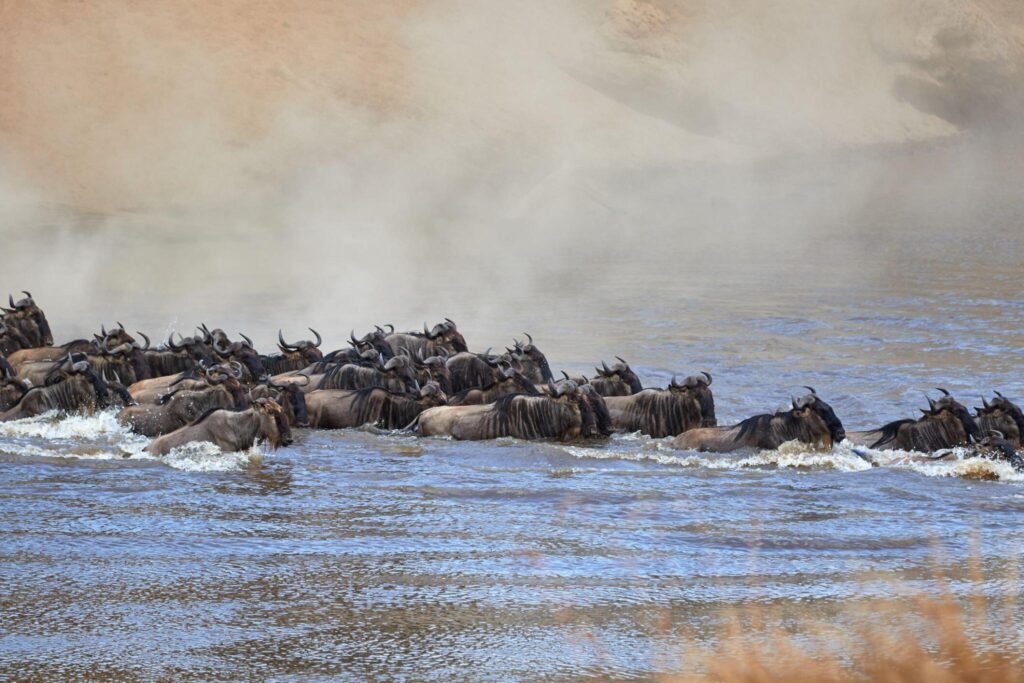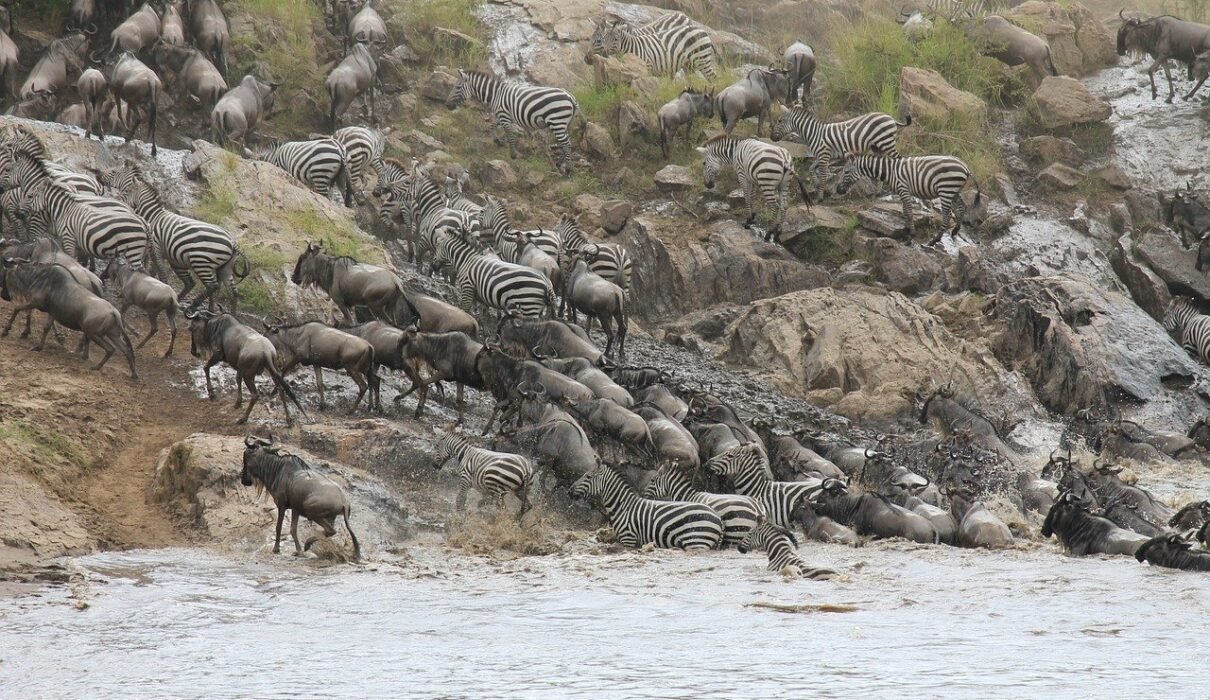The Top 8 Must-Have Items to Take for a Wildebeest Migration Safari in 2025/2026. The Great Migration is one of the most breathtaking wildlife spectacles on Earth, with over 1.5 million wildebeest, along with zebras and gazelles, traveling across the Serengeti and Maasai Mara in search of fresh grasslands. If you’re planning a wildebeest migration safari, being well-prepared with the right gear can make a huge difference in your experience. Here are the 8 must-have items you should pack to ensure your safari is comfortable, safe, and unforgettable.

The Top 8 Must-Have Items to Take for a Wildebeest Migration Safari in 2025/2026 : Binoculars for Wildlife Viewing
When witnessing the Great Migration, having a pair of high-quality binoculars is essential. While you’ll be close to much of the action, binoculars help you spot wildlife in the distance, such as lions stalking their prey or wildebeest crossing the Mara River.
What to Look for in Binoculars:
- Magnification: Opt for at least 8x or 10x magnification for clear and detailed views of distant animals.
- Lightweight: Since you’ll be carrying them throughout the day, choose lightweight and compact models.
Discover more wildlife gear with Kilimanjaro Climb Specialist
The Top 8 Must-Have Items to Take for a Wildebeest Migration Safari in 2025/2026 : Camera and Telephoto Lens for Stunning Photos
Capturing the beauty of the migration is a must. A DSLR or mirrorless camera with a telephoto lens (200mm or higher) will help you capture the drama of the migration, the wildlife encounters, and the stunning landscapes of the Serengeti or Maasai Mara. Don’t forget to bring extra memory cards and batteries to avoid running out of storage or power during crucial moments.
Photography Tip:
- Use a fast shutter speed to capture fast-moving animals and action scenes, such as the wildebeest crossing rivers or predators on the hunt.
The Top 8 Must-Have Items to Take for a Wildebeest Migration Safari in 2025/2026 : Safari-Appropriate Clothing
Comfortable and lightweight clothing is a must when spending long days in the bush. Pack neutral-colored, breathable clothing to blend into the environment and protect yourself from the sun and insects.
Essential Clothing Items:
- Lightweight shirts and pants: Choose moisture-wicking fabrics to keep cool.
- Wide-brimmed hat: Protect yourself from the intense African sun.
- Warm layers: Early morning and evening game drives can be chilly, so bring a jacket or fleece for warmth.
Plan your safari wardrobe with Eddy Tours Safaris
Sunscreen and Sunglasses
The African sun is intense, especially on open plains like the Serengeti. A high-SPF sunscreen and polarized sunglasses are essential for protecting your skin and eyes. Make sure to apply sunscreen frequently, even if the day starts out cloudy.
What to Pack:
- Sunscreen with SPF 30 or higher
- UV-protection sunglasses
Insect Repellent and Anti-Malaria Medications
Insects, particularly mosquitoes, are common in the Serengeti and Maasai Mara, especially during the rainy season. Pack insect repellent containing DEET or picaridin to protect against bites. If you’re visiting during a peak malaria season, consult your doctor about taking anti-malaria medications before your trip.
Additional Items:
- Anti-itch cream for insect bites
- Mosquito net (if not provided by your accommodation)
The Top 8 Must-Have Items to Take for a Wildebeest Migration Safari in 2025/2026 : A Reusable Water Bottle
Staying hydrated during your safari is crucial. You’ll spend long hours under the sun, and dehydration can spoil your experience. Pack a sturdy, reusable water bottle to fill up at your lodge or camp each day. Many camps in the Serengeti and Maasai Mara provide fresh drinking water, so you can avoid single-use plastic bottles.
Hydration Tip:
- Look for a water bottle with insulation to keep your water cool throughout the day.
Get more safari travel tips with Kilimanjaro Climb Specialist
The Top 8 Must-Have Items to Take for a Wildebeest Migration Safari in 2025/2026 : Comfortable Walking Shoes or Boots
While most safari activities are done from the comfort of a safari vehicle, there will be times when you’ll walk around camp or take part in short walking safaris. A pair of comfortable, waterproof walking shoes or hiking boots will keep your feet protected and comfortable.
What to Look for:
- Water-resistant shoes: Useful for walking in damp grass or muddy terrain.
- Ankle support: Essential for uneven ground or rough terrain during guided walks.
The Top 8 Must-Have Items to Take for a Wildebeest Migration Safari in 2025/2026 : Personal First Aid Kit
Even though safari lodges and camps usually provide first aid kits, it’s a good idea to carry your own personal first aid kit. This should include essential items like band-aids, antiseptic wipes, pain relievers, and any prescription medications you may need during your trip.
What to Include:
- Band-aids and blister pads for minor cuts or blisters
- Pain relievers (ibuprofen, aspirin)
- Anti-diarrhea medication for traveler’s stomach issues
Find out more about travel essentials from Eddy Tours Safaris
The Top 8 Must-Have Items to Take for a Wildebeest Migration Safari in 2025/2026 : FAQs
1. When is the best time to see the Great Migration?
The best time to witness the wildebeest migration is from July to September, when the herds cross the Mara River. However, the migration takes place year-round, so there are always opportunities to see this phenomenon in different stages.
2. How long should I plan for a migration safari?
A typical migration safari lasts between 4 to 7 days. This allows ample time to see the migration, explore the park, and enjoy other wildlife encounters.
3. What animals can I expect to see during the migration?
Besides wildebeest, you’ll also see zebras, gazelles, and eland migrating. Predators such as lions, leopards, and hyenas follow the herds, offering dramatic wildlife encounters.
4. What is a river crossing, and where can I see it?
The river crossing is one of the most dramatic events of the migration, where wildebeest and zebras cross crocodile-infested rivers like the Mara River. This typically occurs from July to August in the Northern Serengeti and Maasai Mara.

The Top 8 Must-Have Items to Take for a Wildebeest Migration Safari in 2025/2026 : Ready to Experience the Great Migration?
A wildebeest migration safari is one of the most awe-inspiring experiences nature has to offer. By packing the right essentials, you can ensure your trip is comfortable, safe, and packed with unforgettable wildlife encounters. Whether it’s your first safari or you’re a seasoned traveler, witnessing the Great Migration is an experience you won’t want to miss.
Start planning your migration safari with Kilimanjaro Climb Specialist
Book your wildebeest migration adventure with Eddy Tours Safaris

